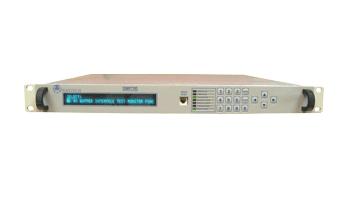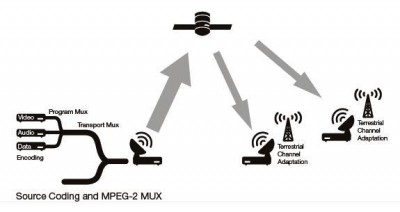AMT 75 High Speed Modem
Advantech’s AMt 75 DVB-S/S2 Broadcast Receiver is designed for the reception and forwarding of digital television signals and/or transmission of high-speed data (IP) over industry standard Digital Video Broadcasting over Satellite (DVB-S/S2).

Features
• Management via 10/100BT with SNMP V3, GUI or RS-232/RS485
• ISI broadband de-multiplexer (selectively retrieves multiple MPEG-TS from carrier)
• ISSY time stamping for stream synchronization
• Null-packet reinsertion
• Optional: BISS encryption support
• Optional: Variable Coding Modulation
• Optional: Adaptive Coding Modulation
• Optional: L-band and 70/140Mhz support
• Optional: Multi-receiver (up to 3 SBR75)
Overview
Advantech’s AMt 75 DVB-S/S2 Broadcast Receiver is designed for the reception and forwarding of digital television signals and/or transmission of high-speed data (IP) over industry standard Digital Video Broadcasting over Satellite (DVB-S/S2). At the heart of the AMT 75 is the Satellite Broadcast receiver (SBR75) which is a low-profi le embedded card in a compact form. For all broadcast applications, this fully featured Demodulator offers unrivalled fl exibility supporting DVB-S2 LDPC coded data rates of up to 130 Mbps in a 36 MHz channel using 32APSK (110 Mbps using 16APSK or 80 Mbps using 8PSK, respectively in a 36Mhz transponder). The card supports both the SHORT FEC frame and the NORMAL FEC frame. The SHORT frame is particularly useful to minimize latency in low data rate contribution applications. This card can also be specifi ed with DVB-S and DVB-DSNG Pragmatic Trellis decoding allowing the demodulation of existing QPSK, 8PSK and 16QAM DVB-S and DVBDSNG PTCM signals. When used in DVB-S2 modes the card offers performance gains of up to 2.5dB compared to older DVB-S systems. This can be translated to approximately a 30% capacity increase in a given transponder bandwidth. This performance gain can be used to either increase the data throughput via a given Satellite bandwidth, therefore signifi cantly reducing transponder costs, to provide more link margin or even to reduce antenna size. The card also supports new DVB-S2 modes of operation, such as Variable Coding Modulation (VCM) and Adaptive Coding Modulations (ACM), which further improve available throughput on given satellite channels. The performance benefi ts, reliability and interoperability of standards based DVB-S2 makes it the ideal solution for broadcasters considering implementing new services or upgrades current deployed DVB-S networks. The SBR75 supports up to 4 DVB ASI ports, providing the means to de-multiplex and remap DVB MPEG Transport streams (TS) to individual ASI ports, from a single carrier. Additionally, an optional 10/100/1000BaseT interface is available providing the means to simultaneously support both ASI and Ethernet based data and video streams. The AMT75 can support up to 3 SBR75 in distinct and/or redundant formation within a 1RU chassis providing compact solution for multi receiver applications.
Applications
• The SBR75/AMT75 is designed to provide best in class performance for critical applications such as:
• Digital Video Broadcast (DVB)
• Digital Satellite News Gathering (DSNG)
• Business enterprise data distribution (ultra high speed IP delivery, e-learning, streaming video and audio)
• Distribution of Digital Terrestrial Transmission
Performance specifications
Data and code rates
DVB-S and Intelsat 308/309 coding
• BPSK: 16kbps to 36Mbps
• QPSK: 16kbps to 70Mbps
DVB-DSNG coding
• QPSK: 64kbps to 70Mbps
• OQPSK: 64kbps to 72Mbps
• 8PSK: 128kbps to 110Mbps
• 16QAM: 128kbps to 120Mbps
DVB-S2 short and normal FEC block coding
• QPSK: 64kbps to 80Mbps
• 8PSK: 256kbps to 120Mbps
• 16APSK: 340kbps to 160Mbps
• 32APSK: 470kbps to 200Mbps
• SHORT Block 16kbit ¼*,1/3*,2/5*,1/2*,3/5,2/3,4/5,5/6,7/8,8/9
• NORMAL Block 64kbit ¼*,1/3*,2/5*,1/2*,3/5,2/3,4/5,5/6,7/8,8/9,9/10
Roll off: 0.15, 0.20, 0.25, 0.30, 0.35
IF Input Connector
• Type N (f) 75Ohm for L-band
• Option: BNC (f) for 70/140Mhz. 50Ohm
• Return loss: ≥10 dB
• LNB Alarm for Short Circuit
RF Input Frequency
• L-band: 950 to 2150Mhz in 1Hz steps
• Optional: 70+/-18Mhz and L-band,140+/-36Mhz and L-band
RF Input Power Levels
• Nominal: 45 dBm - 10log(400/R) dBm, where R = Symbol Rate in kSymbols
• AGC range: +/-20dB minimum
• Max level: 0dBm
Noise Figure
• 9 dB typical, 12 dB at max AGC gain
LNB Power and Control
• Selectable LNB Supply Voltage: ON/OFF, 18 VDC(Horizontal Pol.) or 13 VDC (Vert Pol.)
• LNB Control: 22 +4 kHz single tone burst, amplitude = 0.6 +0.2 V p-p

Data Interfaces
ASI interfaces
• BNC (f), 75 Ohms for ASI
• Encoded Line Rate: 270 Mbps+100 ppm
• Sensitivity (D21.5 idle pattern): 200 mV
• Max. Input Voltage: 880 mV p-p
• Min. Connector Return Loss: 15 dB
• Max. Distance: 150 Meters,10/100/1000BaseT (RJ-45) ports.
Physical and Power Specifications
Dimensions:
• 1RU standalone chassis,19W X 15.75D X 1.75H inches,(48W X 40D X 4.4H cm)
Weight: 8lbs (3.7kgs)
Power: 90 – 264VAC (50/60H) or -48VDC (32 to 72VDC)
Power consumption: 50Watts
Operating temp: 0°C to 45°C (32°F to 122°F)
Storage temp: -25°C to 85°C (-13°F to 185°F)
Relative humidity
Operating: Up to 90% non-condensing
Non-Operating: Up to 95% non-condensing
Altitude
Operating: up to 10,000’ (3,045M)
During Transit: up to 40,000’ (12,180M)










